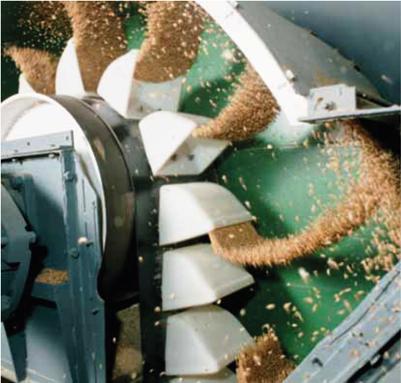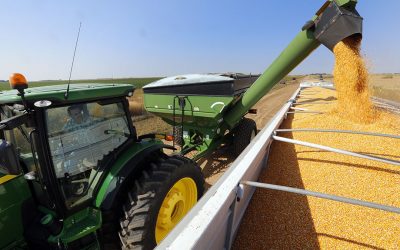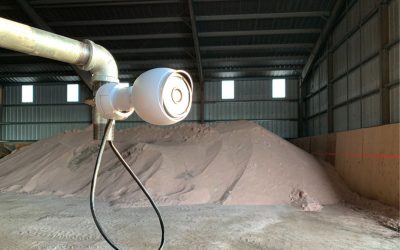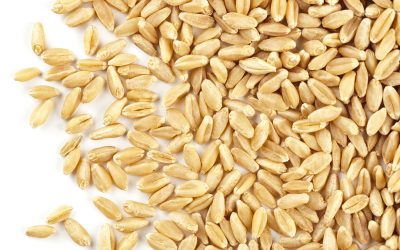Achieving maximum capacity for your bucket elevator

There is a demand for increasing the capacity of new and old bucket elevators particularly for handling grain. Factors that influence the capacity of an elevator are: bucket type, shape and discharge characteristics, optimum speed in relation to pulley size, shape of head and boot, material characteristics such as size, shape and density, angle of repose, coefficient of friction and terminal velocity.
The most common cause for loss of capacity in an elevator is the bucket discharge, which can be caused by the incorrect belt speed in relation to the pulley diameter, the wrong elevator bucket for the material and the wrong head shape. Table 1 shows the three types of discharge and their common characteristics.
Centrifugal discharge is normally used for grain and other materials which are handled at medium to high belt speeds. The material will start discharging from the bucket at about 10 o’clock (see photo) from the horizontal and continues discharging around the pulley in arcs towards the head cover and outlet until empty.
It is necessary to design the head cover so that the material will slide smoothly along the cover to the outlet (Figure 1), minimising the amount of dust created and material damage. A flat top cover design as well as any break in the head cover, such as explosion vents or gaps, will make the material rebound onto the pulley and will result in material back legging and/or down legging.
There is a minimum and maximum centrifugal belt speed for each different bucket size and pulley diameter. The recommended elevator bucket types for centrifugal discharge are CC-S, J-Steel, Starco, Super Starco and bottomless buckets. It is best to consult the manufacturer for speed recommendation.Centri-gravity discharge is normally used for discharging powders, pellets, cement and fragile materials at slow speeds. The elevator buckets start to discharge at top dead centre (12 o’clock) and continue until approximately 50° afterwards. Recommended bucket types for centri-gravity discharge are Super Starco Steel and Starco Jumbo (SJ) buckets.
Gravity discharge is typically used for discharging sluggish, aerated materials which basically fall out of the buckets at around the 2 o’clock position. Slow running continuous elevator buckets can be used for gentle handling of fragile materials.
Other considerations
Along with bucket discharge, there are other factors to consider that can also affect your bucket elevator’s capacity, such as bucket fill. Material enters an elevator bucket through the front and the sides. Buckets with straight sides do not fill as well as buckets with tapered sides. As shown in Figure 2, CC-S, Starco and Super Starco buckets have tapered sides which allow them to fully fill and discharge material better than any other CC type bucket.
Along with bucket discharge, there are other factors to consider that can also affect your bucket elevator’s capacity, such as bucket fill. Material enters an elevator bucket through the front and the sides. Buckets with straight sides do not fill as well as buckets with tapered sides. As shown in Figure 2, CC-S, Starco and Super Starco buckets have tapered sides which allow them to fully fill and discharge material better than any other CC type bucket.
To facilitate the discharge of material from the elevator head, the outlet should be large enough for the required capacity and should be at minimum 45° from the head shaft for grain and low friction particles. For other products such as meals, cement, sticky materials, and wood chips, the outlet should be at 50° to 55°.
Regarding the elevator beltit is important to maintain proper belt tension to help avoid belt slippage on the drive pulley. A lagged head pulley will help reduce slip and wear on the belt. It is recommended to always install belt slip, belt misalignment and bearing temperature monitoring systems to help with safety and maintenance requirements.
To ensure an efficient intake and reduce material damage and dust, the intake should be placed at a minimum angle of 45° from horizontal when handling grain, 50° for meals or pellets and 55° for industrial materials, to a point at least 4 inches (10 cm) above the line of the boot shaft so that material is directly fed into the buckets. The area of the intake should be large enough for the required volume of material. When handling grain, fitting a liner in the boot 1 to 2 inches (2.5-5 cm) from the lower bucket tip will increase the bucket fill, reduce grain damage and the amount of power required.
Most boot pulleys for grain are smooth surfaced, but for sticky meals which build up on the inside of the belt and cause belt stretch as well as other belt issues; a wing type pulley (Figure 3) is best as it allows the surplus material to fall through the wings instead of building up between the pulley and the belt. A wing type pulley also reduces damage to pellets.
Join 26,000+ subscribers
Subscribe to our newsletter to stay updated about all the need-to-know content in the feed sector, three times a week. Beheer
Beheer









 WP Admin
WP Admin  Bewerk bericht
Bewerk bericht